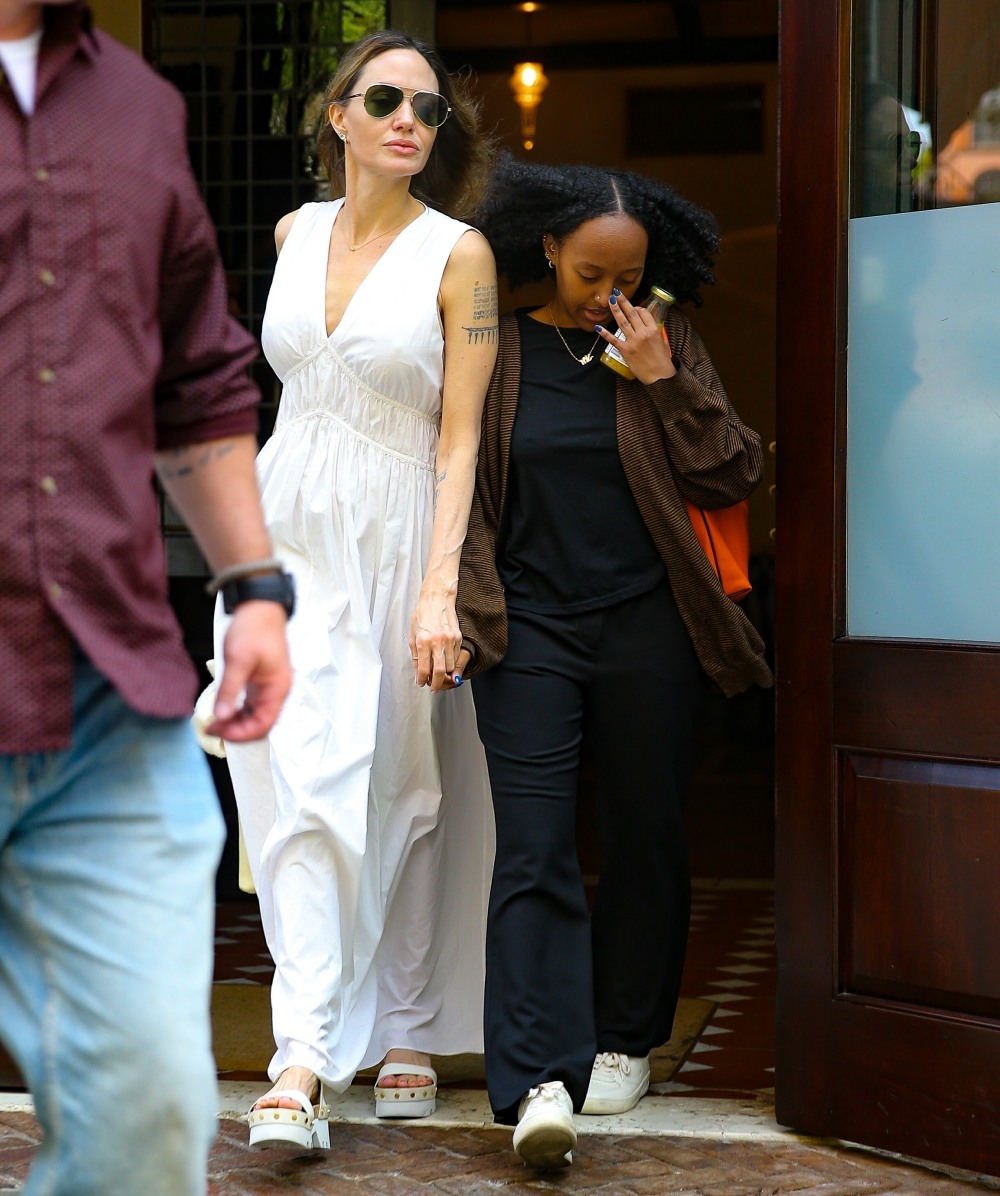Here are some photos of Angelina Jolie and Zahara out in New York last week. Angelina clearly misses Zahara like crazy, and in Zahara’s first year at Spelman College, Angelina looked for any excuse to fly to Atlanta to see her daughter, and any time Zahara had time off, Angelina arranged for a girls’ trip to New York and more. I assume the trip last week was something fun for Zahara after her spring semester ended.
Meanwhile, at the end of 2022, Jolie stepped down from her position of special envoy to the UNHCR. She had worked with the UNHCR (in different positions) for 21 years. Many of us Jolie-stans wondered what she would do next, whether she would work for some smaller refugee organization. Well, we’re getting an answer… sort of. Angelina has announced that she’s starting Atelier Jolie, which is a fashion collective which will employ refugees and hopefully utilize some refugee fashion creatives.
The actress, director, and former United Nations goodwill ambassador and special envoy is launching Atelier Jolie, a new purpose-driven brand that will utilize deadstock and tap into the abilities of “refugees and other talented, under-appreciated groups, with positions of dignity based on skill.”
Jolie posted the news on her Instagram account, writing, “I’m starting something new today—a collective where everyone can create… Atelier Jolie is a place for creative people to collaborate with a skilled and diverse family of expert tailors, pattern makers, and artisans from around the world. It stems for my appreciation and deep respect for the many tailors and makers I’ve worked with over the years, a desire to make use of the high quality vintage material and deadstock material already available, and also to be part of a movement to cultivate more self-expression.”
More than 100 million tons of textile waste dead-end in landfills every year. Atelier Jolie seems designed to address that crisis. According to the brand website: “You will be able to repair or upcycle pieces from your closet you wish to revive, perfecting fit, breathing new life into what could have been thrown away, and creating quality heirloom garments with personal meaning.”
The mention of refugees is intriguing given the end last week of Title 42, a pandemic-era measure that allowed authorities to quickly turn back migrants on public health grounds. The U.S. could see record numbers of asylum seekers moving forward. Whatever Atelier Jolie becomes, Jolie is particularly well-placed to disrupt in this area.
I wonder if this collective is going to be LA-based or international or what. How are they getting their hands on “deadstock” and what will the larger organization look like? I don’t doubt Angelina, but it just sounds like a huge project. Perhaps she’s already employing refugee creatives to work out this enormous undertaking. It will be interesting to see… a collective making sack dresses out of deadstock. Please, let some of those refugee stylists get ahold of Angelina and get her to wear some different silhouettes!
Photos courtesy of Backgrid.
- New York, NY – Angelina Jolie and her daughter Zahara are pictured exiting the Greenwich Hotel in New York City. Pictured: Angelina Jolie, Zahara Marley Jolie-Pitt BACKGRID USA 18 MAY 2023 BYLINE MUST READ: Fernando Ramales / BACKGRID USA: +1 310 798 9111 / usasales@backgrid.com UK: +44 208 344 2007 / uksales@backgrid.com *UK Clients – Pictures Containing Children Please Pixelate Face Prior To Publication*
- New York, NY – Angelina Jolie and her daughter Zahara are pictured exiting the Greenwich Hotel in New York City. Pictured: Angelina Jolie, Zahara Marley Jolie-Pitt BACKGRID USA 18 MAY 2023 BYLINE MUST READ: Fernando Ramales / BACKGRID USA: +1 310 798 9111 / usasales@backgrid.com UK: +44 208 344 2007 / uksales@backgrid.com *UK Clients – Pictures Containing Children Please Pixelate Face Prior To Publication*
- New York, NY – Angelina Jolie and her daughter Zahara are pictured exiting the Greenwich Hotel in New York City. Pictured: Angelina Jolie, Zahara Marley Jolie-Pitt BACKGRID USA 18 MAY 2023 BYLINE MUST READ: Fernando Ramales / BACKGRID USA: +1 310 798 9111 / usasales@backgrid.com UK: +44 208 344 2007 / uksales@backgrid.com *UK Clients – Pictures Containing Children Please Pixelate Face Prior To Publication*















Sounds like they are co-opting the creative work of the Suay project from LA.
Wow. Thanks for the introduction to Suay project! But it sounds like they’re more into repurposing garments headed to the landfill, rather than mill ends or production run ends. Hadn’t really thought about deadstock before, but have now discovered Blackbird Fabrics online. Haven’t sewed for years, but figured out how to thread my sewing machine last night!
Jolie’s project sounds great. Lots of clothes that get dropped off at Goodwill, Salvation Army, etc wind up being foisted off to developing countries on another continent.
This is great and unlike Kaiser, I think this is well planned. Jolie has worked with refugees before and has plenty of knowledge about how the fashion industry rolls. Also, thank God for more sack dresses; let the woman wear what she likes.
Do people really throw away that many clothes and fabrics that can be used? Have they never heard of thrift stores? consignment shops? charities?
Fashion deadstock is generally on a huge scale, like mass manufacturers that order thousands of feet of floral fabric and then scratch it for one of the leaf shades being off. My favourite lingerie brand (ColieCo) uses it and gave a good explainer on their website.
Yes. This is what’s been happening with deadstock. The United Nations is mentioned in the bit of the article shown.
https://www.nationalgeographic.com/environment/article/chile-fashion-pollution
Exactly!
While we as individuals can do what we can: buying less, buying used, donating to thrift shops, reselling and disposing of unusable items appropriately (the state I live in banned disposing textiles in trash last year*, there are collection bins now outside schools town halls etc)
the waste happening from industrial, commercial enterprises is on a whole other scale (see also pollution, energy consumption, carbon emissions, water use)
* I had a dust up with a friend this weekend- she’d been helping me go through my closets to clear things out that I’m not using; because I used to have family living with me, I had a LOT of old pillows that used to go on beds, sleeper sofas I no longer need (or even have in some cases). Local thrift stores won’t take them; she wanted to take them to a dumpster and was upset for some reason that I insisted we set them aside so I could put them in the local textile waste drop off. I think it was a mindset thing … she sometimes is reflexively dismissive of what she thinks is “woke” which I think in her mind includes regulation of the waste stream. In my mind I was still clearing out my closets and the textiles bin is literally a half mile away from the dumpster she was aiming for so it wasn’t any harder to dispose of them in the “right” place. I dubbed my little car “the pillow car” filled it to the brim, and went to the textiles bin that same day.
We should also call out the higher fashion houses that will dump and destroy their inventory instead of selling it at a fraction of the price. They all have this mindset that they would rather fill up the landfills instead of selling outdated or unsold merchandise as it would “ruin” the value of the products.
The last time I looked into it, something like 70-90% of donated clothes ended up going unsold and were not needed in the local community, and ended up being recycled.
They also sell the unsold donated items and ship them to poorer countries which they hand out or others will buy them in bulk to sell at local street vendors. Unfortunately, millions of clothing that isn’t purchased is dumped into the massive dumping grounds in these countries which adds to their pollution as it becomes much too massive to contain. It’s atrocious to dump trash into countries that do not have the resources to properly recycle or reinvest the massive fast fashion.
Thrift stores long ago reached capacity for selling usable clothing. The thrift shops in my area only sell upper-end brands. Most clothes deemed unsellable are turned into ballast/cushioning bales and used on cargo/container ships. The bales are either sold for pennies on the pound or abandoned at the docks of poorer countries. Market Place, a CBC consumer show, did a clothing/fabric waste episode. Freightened: The Real Price of Shipping is a terrifically horrifying documentary on the shipping industry. But, this issue, waste fabric, is just the visual tipping point. What can you do? Buy quality, non-synthetic, classically styled clothing, take proper care, and wear them for a long time. Mend your clothes creatively (it’s called “visible mending” and is a growing trend). Buy fewer shoes–most are not recyclable. Care less about what you think others think about your clothes.
Equality,
I am by no means an expert, but I have heard/read that a lot of clothing donations end up in landfills. Purely speculating here on why, but I would think that maybe thrift stores etc get a lot of stuff they can’t use, and that gets passed on to landfills. For example, jeans, even if we all donate pairs that are in good shape, I imagine they get way more pairs of jeans than they could ever sell.
I just love her.
I would love to take my clothes that have ripped, frayed, or have holes, or no longer fit to some kind of upcycling tailor or designer who could make something new and exciting out of them. That could change the fashion industry entirely.
Someone I know from high school is doing that, repurposing clothing to make jackets. Personally I don’t care for the style of them, but I guess she’s doing pretty well with it.
For anyone with bedding, pillows, towels, etc – check your local animal shelter, they usually will take all of that and greatly appreciate it.
I saw her Instagram and I am thrilled!
I was intrigued to see what would come out next after her initial announcement.
I follow Nona Source on IG, they were set up to give access to LVMH deadstock so other creatives can buy them and use them. They are absolutely beautiful and I wish I had greater skill with a sewing machine!
Its slow but change is happening in the fashion industry.
What a wonderful idea for a social enterprise. I work for an organisation that supports children in schools developing their own social enterprises, and one of the schools I work with does this exact thing, albeit on a much smaller scale. Their town is in a traditional textile-producing area and they, on their own initiative, contacted the local manufacturers for their off-cuts and deadstock. They’ll be so excited to hear that Angelina Jolie had a similar idea!
There are literal warehouses in LA with deadstock. Revival Clothing (based in Montana) owner did a video last year of picking deadstock for her summer collection. It is easy as walking into a warehouse, picking, they bundle and you are off.
I’ve never heard of dead stock. I assumed unused but new fabric was sold as vintage.
What a huge waste to landfill it.
AJ can wear whatever she wants to, no judgement from me.
I prefer her relaxed dressing style to the sheer dresses, cut out panels, etc.
I loved the idea but at the same time I’m apprehensive.
When I saw her post about Atelier Jolie, I was excited for her and for me because I know where I am going to get my clothes from this fall:)
Its crazy there is still a deadstock problem. Over 20 years ago it had a different name but we spoke about this problem. Established Fashion houses and new houses says this problem would be no more. Ridiculous.
I’m a great admirer of her style, and find her very aspirational, so I’ll be interested in seeing what her Atelier turns out. I hope the price points will be within my reach.
This sounds great!
I shop at thrift stores mostly. I have found amazing things, like Rebecca Taylor, Temperley, Prada, and I collect vintage bags. Goodwill prices drive me crazy though, they are too high. (Then again I have found real Blahnik heels for ten dollars, while tattered old Aerosoles are twenty! So I guess it evens out if you happen to go the right day.)
Good Will is so hit and miss, but that’s part of the fun I guess. I sell on line. Bags do very well, as least certain brands.
I can’t wait to see what they create.
I think this sounds like a good project! I sell clothes on line, almost entirely pre-owned (and vintage). It’s kind of a “big little industry.” I don’t do dead stock stuff but there is plenty to be had, even new with tags, at thrift stores where I live (Texas). It’s amazing how many things people buy that they end up donating barely worn if at all. Whatever doesn’t get purchased is bundled and sold or donated to other countries. That’s one way to good use of pre-owned clothing and reduce waste. What Angelina is doing is another, it seems.
Looking at the posts above I see that a lot of these clothes shipped overseas are causing problems. That’s a shame. I am all about recycling but also about not creating unnecessary items (or dumping them to inflate prices) in the first place.
Once again Angelina Jolie leading the way, this is such a worthy initiative and will givd many designer’s, tailors their rightful rights. As always Angelina Jolie leading the way to help others and make a change
Anything Angelina take part of has always been for people (wherever that may be) is for the good… How many Celebrities out there that throw their wealth around to make egotistical impression, its pathetic !!! This World doesn’t have to have division of our existence … Money can be distributed better if some people think of others as another Human beings … Hoarding can be avoided in ways of sharing … I’m an old Designer/ Seamstress, I would love to be part of an attempt to better other lives… More Power to you Angelina !!!💞
I hope you’re able to take part in this collective.